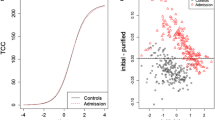Abstract
Sex, socioeconomic status, intelligence, a clinical symptom score, and an index of abnormal psychosocial situations as proposed by a recent WHO draft were studied as correlates of the Global Assessment of Functioning Scale (GAFS), which comprises Axis V of theDSM-III-R. Whereas all parameters correlated significantly with the GAFS score, only total symptom domain score displayed a meaningful association. It was concluded that the GAFS contributes significantly to clinical information as an independent source.
Résumé
Le sexe, le statut socio-économique, l'intelligence, le score des symptômes cliniques, et un index de situations psychosociales anormales proposés par un récent projet del'OMS furent étudiés en corrélation avec l'évaluation globale de l'échelle de fonctionnement (Global Assessment of Functioning Scale G.A.F.S.) qui correspond à l'axe V du DSM III R. Tandis que tous les paramètres sont corrélés significativement avec un score GAFS, seul le score symptomatique total n'offre pas d'association significative. Les auteurs ont conclu que le GAFS contribue significativement à l'information clinique en tant que source indépendante.
Zusammenfassung
Es wurden ein klinischer Symptomwert, ein Index für abnorme psychosoziale Situationen gemäß einem unlängst erschienenen WHO-Dokument, Geschlecht, sozioökonomischer Status und Intelligenz als Korrelate der Global Assessment of Functioning Scale (GAFS) untersucht, welche die Achse V des DSM-III-R bildet. Während alle Parameter
Similar content being viewed by others
References
Bird, H.R., Canino, G., Rubio-Stipec, M. & Ribera, J.C. (1987). Further measures of the psychometric properties of the children's global assessment scale.Archives of General Psychiatry, 44, 821–824.
Bird, H.R., Canino, G., Rubio-Stipec, M., Gould, M.S., Ribera, J., Sesman, M., Woodbury, M., Huertas-Goldmann, S., Pagan, A., Sanchez-Lacay, A. & Moscoso, M. (1988). Estimates of the prevalence of childhood maladjustment in a community survey in Puerto Rico.Archives of General Psychiatry, 45, 1120–1126.
Bird, H.R., Yager, T.J., Staghezza, B., Could, M.S., Canino, G. & Rubio-Stipec, M. (1990). Impairment in the epidemiological measurement of childhood psychopathology in the community.Journal of the American Academy of Child and Adolescent Psychiatry, 29 (5), 796–803.
Cohen, N.J., Kolers, N. & Bradley, S. (1990). Relation of global ratings of functioning with behaviour and development in delayed and disturbed preschoolers.Canadian Journal of Psychiatry, 25, 514–518.
Endicott, J., Spitzer, R.L., Fleiss, J.L. & Cohen, J. (1976). The global assessment scale. A procedure for measuring overall severity of psychiatric disturbance.Archives of General Psychiatry, 40, 1228–1231.
Goor-Lambo, G. van, Orley, J., Poustka, F. & Rutter, M. (1990). Classification of abnormal psychosocial situations: Preliminary report of a revision of a WHO scheme.Journal of Child Psychology and Psychiatry, 31 (2), 229–241.
Kleining, G. & Moore, H. (1968). Soziale Selbsteinstufung.Kölner Zeitschrift für Soziologie und Sozialpsychologie, 20, 502–552.
Shaffer, D., Gould, M.S. & Brasic, J. (1983). A children's global assessment scale (CGAS).Archives of General Psychiatry, 40, 1228–1231.
Steinhausen, H.-C. (1987). Global assessment of child psychopathology.Journal of the American Academy of Child and Adolescent Psychiatry, 26, 203–206.
Steihausen, H.-C. & Erdin, A. (1991a). A comparison of ICD-9 and ICD-10 diagnoses of child and adolescent psychiatric disorder.Journal of Child Psychology and Psychiatry, 32, 909–920.
Steinhausen, H.-C. & Erdin, A. (1991b). The interrater reliability of child and adolescent psychiatric disorder in ICD-10.Journal of Child Psychology and Psychiatry, 32, 921–928.
Steinhausen, H.-C. & Erdin, A.: Abnormal psychosocial situations and ICD-10 diagnoses in children and adolescents attending a psychiatric service.Journal of Child Psychology and Psychiatry (in press).
Weissmann, M.M., Warner, V. & Fendrich, M. (1990). Applying impairment criteria to children's psychiatric diagnosis.Journal of the American Academy of Child and Adolescent Psychiatry, 29, 789–795.
World Health Organization (1988). Draft multi-axial classification of child psychiatric disorders. Axis 5: Associated abnormal psychosocial situations. Geneva: World Health Organization.
Author information
Authors and Affiliations
Rights and permissions
About this article
Cite this article
Steinhausen, HC., Erdin, A. Correlates of the DSM-III-R global assessment of functioning scale in patients attending a child and adolescent psychiatric service. European Child & Adolescent Psychiatry 1, 105–110 (1992). https://doi.org/10.1007/BF02091793
Issue Date:
DOI: https://doi.org/10.1007/BF02091793




